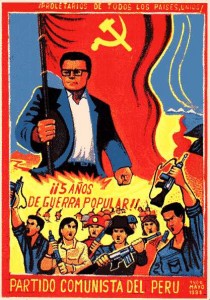 You may or may not know about Shining Path before you go to study Spanish in Peru. While the group is not very active today, this organization and its violent past had a major role in shaping Peru’s political terrain.
You may or may not know about Shining Path before you go to study Spanish in Peru. While the group is not very active today, this organization and its violent past had a major role in shaping Peru’s political terrain.
Shining Path became well known and grew in strength during the 1980s. This organization sought to bring communism to Peru and used torture, terrorism and murder to get its points across. The group’s founder, Abimael Guzman, is notorious for his harsh statements, such as “The triumph of the revolution will cost a million lives.”
The way the government initially handled Shining Path is believed to have added to its growth. The government never declared this group’s violent actions to be an emergency. In fact, the Interior Minister of the country mistakenly believed that police actions could take care of the organizations. As the government played down Shining Path’s significance, peasants interpreted this action to mean that the government did not care about them. Some peasants then began to support Shining Path’s goal of overthrowing the government.
As 1981 came to a close, the government finally declared the Andean regions where Shining Path was operating to be an “emergency zone.” Many innocent people were arrested and unfortunately some massacres were caused by military forces and police. The military trained peasants and organized them to fight in anti-rebel militias to attack the guerillas. In response, Shining Path killed 69 peasants during the Lucanamarca massacre. The guerillas continued to kill peasants in different areas and also set up labor camps where they imprisoned people.
Shining Path also carried out attacks in Lima including sabotaging electrical transmission towers and setting up bombs in government offices. Many civilians were killed and injured during the famous Tarata Street bombing in Miraflores.
By the end of the 1980s, Shining Path controlled much of the countryside in Central and Southern Peru. Guzman grew to be more and more popular, even as his actions became more and more violent and oppressive. The group outright rejected belief in human rights. An official document stated, “We reject and condemn human rights because they are bourgeois, reactionary, counterrevolutionary rights, and are today a weapon of revisionists and imperialists, principally Yankee imperialists.” The group also showed great disrespect for indigenous traditions, beliefs, and rights.
On September 12, 1992, the Peruvian government struck a huge blow against Shining Path by capturing its leader, Abimael Guzman. Since there was no secondary leader, the group ultimately splintered into several smaller, less powerful factions and the end result was far less guerilla activity.
Although the war with Shining Path officially ended in 2000, violent incidents continued to occur. In 2003, the Peruvian National Police infiltrated a training camp, where they found about 100 indigenous people who were working as slaves. In 2008, rebels killed 4 police with grenades and automatic weapons. In 2009, Shining Path killed 13 government soldiers.
Luckily, when you attend language school in Peru, you will no longer see or hear about Shining Path activities. The government has, finally, mostly shut down the group. The few factions that remain focus on cocaine production and trafficking rather than revolution. However, if you are going to study Spanish in Peru, it is important to understand the tumultuous history of this organization.